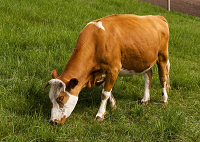Last year, biologist Susanne Åkesson at Lund University in Sweden, together with researchers in Hungary, received the Ig Nobel Prize in Physics. The prize was awarded to them for their research showing that dark-coated horses suffer more from blood-sucking horseflies compared to their white counterparts. Now, the researchers know why animals with a dark, smooth coat are particularly vulnerable — even in a dark environment.
When the sun shines on horses and cows with black or dark-brown coats, polarised light is reflected — a light to which horseflies (tabanidae) are both sensitive and attracted. White-coated animals are largely protected by the fact that their coats reflect unpolarised light. For these discoveries, which were published for the first time in 2010, the researchers were awarded the Ig Nobel Prize last year — a prize awarded for research findings that are both entertaining and make people think.
Professor Susanne Åkesson and her colleagues in Hungary have proceeded by finding out why female horseflies can easily identify dark coats among other equally dark patches in their field of vision.
In a new study, they show that horseflies are able to identify dark cows even when they are standing in front of shrubbery and other vegetation where certain parts are as dark as the cows’ coats. When the sun shines, the smooth coats of the cows strongly reflect polarised light. Vegetation does not reflect light in this way; the leaves are often matte and less shiny in the sun compared to dark, smooth coats whose individual hairs all point in the same direction.
“In this study, we show that the polarised light reflected from a dark coat differs from polarised light reflected from other dark surfaces in the surroundings,” says Professor Susanne Åkesson.
“Previously, we discovered that horseflies see, and are attracted to, polarised light, but not how polarised light reflected from dark, smooth coats differs from other polarised light.”
As the vegetation does not reflect polarised light to the same extent as a dark coat, the horseflies are able to see the dark-coated cow much more clearly compared to foliage and other vegetation.
The researchers used a dark model cow, placed in front of different types of vegetation under different lighting conditions, and measured the polarised light reflected from both the vegetation and the model cow. The results showed that when sun shines on a dark-coated cow, it produces highly polarised light that makes the cow easily identifiable and detectable to horseflies. The results are supported by equivalent measurements taken on a living black cow standing in the shade and in sunshine, respectively.
The most efficient way for female horseflies to find a host animal is thus to use their vision and sensitivity to polarised light to find sunlit dark patches that reflect a lot of polarised light. Chances are that such patches, unlike other dark patches in the environment, are host animals from which they can suck blood.
“A dark cow bathing in the sunshine and strongly reflecting polarised light makes it easy for the horseflies,” says Susanne Åkesson.
Send your message to us:
Post time: Jun-13-2019


